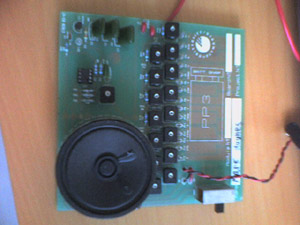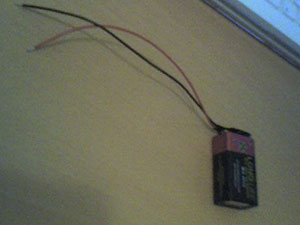Switches
Posted: 15 March 2006 Filed under: Critical Context Leave a commentI had another meeting with Bill from the Electronics school yesterday. Following on from the method I think I’m gonna use now with all my different components, I wanted to find out how I could find out if the switch had been pressed or not. It doesn’t look as though it’s gonna be as straightforward as I had hoped. The switch has a piece of carbon at the bottom of it (see the photo below) which when pressed against the black squiggly line (sorry for the technical term there) in the gold patch (see the 2nd photo) completes the circuit and makes the bulb glow and the buzzer buzz. Bill reckons if I didn’t want the bulbs to glow as well it would be fairly easy to do what I want but the bulbs are complicating matters.
He suggested that I get 4 x Photo Mos switches, 1 for each switch, then hack into the circuit board to connect them up and then in turn connect them to my wiring board or to the pulse circuits – which he suggested would be the better option. So, another trip to Maplins is needed which is fine but the hacking into the circuit board is gonna be interesting.


Winds of change?
Posted: 14 March 2006 Filed under: Critical Context Leave a commentStill can’t get the buzzer to buzz – this is starting to be a bit of a recurring theme. Thanks to Pete, Bob and Bill from the Electronics school, I’m not sa as down about it as I was a couple of weeks ago. What it does mean though is a bit of a re-think on the roles of the components that make the Simontron up. Originally the Simon was gonna be the key. It was gonna send signals to the PC via the Wiring board which in turn will remember and “play” the sequence of buttons pressed back to the Simon. Now though, with the generating of the sound being done by the pulse circuits board the Simon will have less to do. The buttons will still need to be pressed and the lights will still need to flash but I think the Wiring board will now be the integral part. For example if blue has been pressed, something will need to control which sound is played and I think using Wiring to control it is the answer.
Ask me again in a couple of days when I’ve tried to connect up a test 🙂
Simontron speaks
Posted: 12 March 2006 Filed under: Critical Context Leave a commentI’ve now managed to connect one of the pulse circuits up to the Simon and got it to make a noise. But I’m using the speaker on the new board rather than the buzzer built into the Simon. I’ve tried connecting the buzzer up to the board but still no go. That’s a bit of a pity coz I really wanted Simontron’s “voice” to be the original from the Simon. I’ll keep having a hack around and see if I can suss it. I’m thinking of disconnecting the onboard speaker and going straight to the buzzer but I’m a bit wary of my “new” skills and not being able to connect the speaker up again later if I still can’t get the buzzer to buzz. That sounds a bit familiar doesn’t it??? Anyway, have a quick listen to the Simontron below.
Pulse circuit again
Posted: 6 March 2006 Filed under: Critical Context Leave a commentOh yes!!! I’ve got my circuit. Simontron is back on course!!!

Pulse Circuit
Posted: 4 March 2006 Filed under: Critical Context Leave a commentAfter having a chat with Joasia about the problems I’m having with making the buzzer buzz, she put me in contact with Peter White. I explained what I was trying to do and showed him Simon. He then got out this big box of electronic tricks with dials and a little TV screen built in, switched it on, twiddled a couple of the dials, stuck a couple of probes onto the buzzer which then buzzed. He twiddled a dial somemore and it still buzzed but a bit higher. He then explained that what I need is a pulse circuit which essentially runs at different frequencies to produce a different pitch from the buzzer. As I was gonna need 4 different sounds I was gonna need 4 circuits. Still not really knowing much about electronics I asked him how I could make one. He rang someone else in his department who had an idea that might work. On the electronics course, they have to make some sort of organ which essentially is a load of pulse circuits on a board and hopefully there’ll be an old one lying around that I could have and then bend into a Simontron.
You have no idea how pleased I was when I heard that. After spending weeks going thru’ the board in Simon and running a current thru every single pot and getting more and more frustrated thuis this was fantastic news. I’ve got to pop along to a lab and see speak to someone else who hopefully will be able to track one down for me. I’m gonna see him Monday morning and with any luck I’ll be back on track.
Top quote
Posted: 28 February 2006 Filed under: Critical Context, Ramblings | Tags: Critical Context, simontron, toy Leave a commentI was trying to explain my idea behind The Simontron to a friend of mine. Why I was doing it and a little bit about what hacking and circuit-bending is all about. He then started calling me a particular name and mis-quoting something from our childhoods. He said that in effect I was “making good use of the things that I found, things that the everyday folks leave behind”.
First person to leave a comment saying where the quote is from and what he accused me of bieng being wins a chunky kit kat.
Anyway, turns out that a brother of a colleague of his did electrical engineering at uni and might be able to help me. Well, for the price of a curry and a few beers it might very well be worth it.
No buzz
Posted: 21 February 2006 Filed under: Critical Context Leave a commentI had a chat with Dan last week coz I wasted so much time trying to find how to make the Simon buzz that I was worried that I was falling begind behind. It’s a simple buzzer (apparently) so it will buzz just by running different strength currents thru’ it. Well, I’ve just spent the morning trying that and I only get something using my hacked together 9v probe which is pretty strange considering that the total voltage with the batteries that are supposed to be in it add up to 4.5v. I’m gonna have another trawl thru the net and my electronics kit and see if I can work out what is supposed to happen.
I really don’t want to detract from tuerning turning this into some sort of programmable sound machine. I’ve had loads of positive responses from people so I don’t think it’s such a dumb idea. And for those who do, tough – I ain’t listening 🙂
The crusade continues……
More pots
Posted: 12 February 2006 Filed under: Critical Context Leave a commentDunno if I’m making any progress with this or not. I’ve found a pot which makes a crackling sound when I link it with one of the pots I found below. I’ve been at it for 3 hours and that’s as far as I’ve got…apart from a slight burning smell. Nothing has gone black so I’m erring on the side of caution and gonna stop.
Pots
Posted: 11 February 2006 Filed under: Critical Context Leave a commentI got one of those battery connector thingys for a 9v battery and as you can see below it has 2 long leads that I have been able to use as probes. I touched the pots that I found last week and I’ve been able to turn the lights on but no sound which I had a bad feeling about last week. I’ve had a quick poke around with my new probe but didn’t have much success. I’ll have more time tomorrow so I’ll give it another go then.


Oopsie update
Posted: 5 February 2006 Filed under: Critical Context Leave a commentI’ve got soem some good news today. I manged to get the 4th bulb out and repaired both the cut and the broken wires without either burning my fingers or getting solder everywhere. I even managed to track down a multimeter I had from a previous life so I was able to test all of the pots. I think I’ve found the ones I need but I’m not totally convinced that I can get both the bulb and the buzzer to activate when I run a current thru’ it. I’m gonna try and rig something up with a battery and a couple of wires and try it that way before soldering them up to my board.
Oh yeah, and Argyle lost.